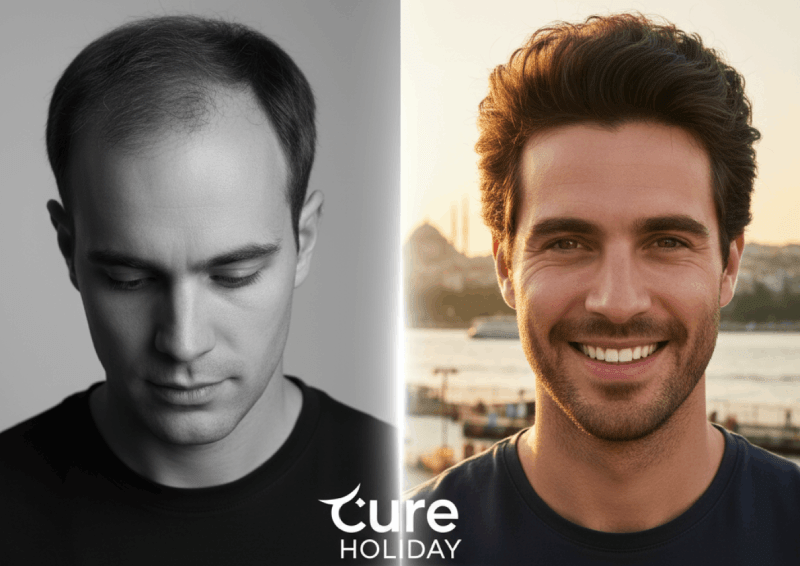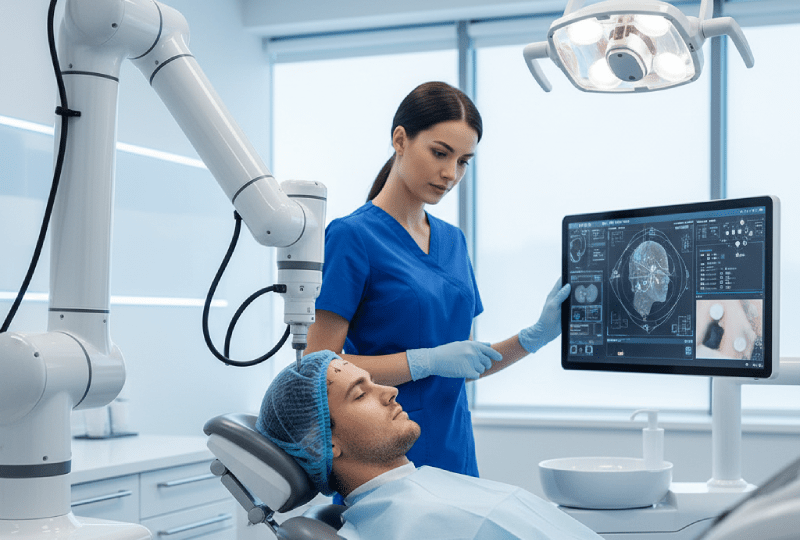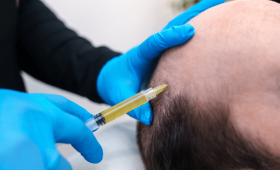What Is Hair Transplantation In Manchester And How Does It Work?
Hair transplantation is a procedure performed by specialist clinics in Manchester where healthy, shed-resistant hair follicles (grafts) are harvested from the back of the scalp and transplanted to bald or thinning areas. This surgical procedure is carried out under local anesthesia and typically lasts several hours. The main goal is to improve the patient’s aesthetic appearance by creating a natural and permanent hairline. Thanks to the high clinical standards in the UK, the procedure is performed with modern techniques and meticulous care, ensuring patients achieve reliable results.
Why Should Manchester Be Preferred For Hair Transplantation In The UK?
Manchester stands out as a developed center for medical tourism and aesthetic surgery in the United Kingdom (UK). Clinics in the city must comply with strict UK health regulations (such as CQC), which guarantees high standards of hygiene and safety. Patients benefit from the comfort of receiving treatment under the legal assurances of their own country without the complications of international travel. However, prices in Manchester tend to be significantly above the European average, and this cost difference directs many patients toward international centers that offer more comprehensive services.
What Are The Quality Standards Of Clinics In Manchester?
Hair transplant clinics in Manchester are obliged to comply with the high standards set by the CQC (Care Quality Commission), the UK’s healthcare regulator. These regulations cover clinic hygiene, the modernity of equipment, the qualifications of the surgical team, and patient safety protocols. These inspections ensure that patients receive the best and safest possible care. Adherence to quality standards is vital for successful outcomes and minimal risk, but these high standards inevitably increase costs, necessitating international comparison.
What Are The Main Differences Between FUE And DHI Techniques?
The main difference between FUE (Follicular Unit Extraction) and DHI (Direct Hair Implantation) lies in the implantation stage. In FUE, after the grafts are collected, channels are opened in the recipient area, and the grafts are placed into these channels. In DHI, channel opening and graft placement are done simultaneously using a specialized tool (Choi Implanter). DHI allows for denser implantation and working between existing hairs, while FUE is often preferred for quickly covering large areas; both are effective methods.
What Is The Preparation Process Like Before The Hair Transplant Procedure?
The preparation process before the hair transplant procedure is vitally important for the success of the outcome. Patients are usually asked to stop taking blood-thinning medications, and cease alcohol and smoking consumption at least one week before the procedure. These substances can increase bleeding and slow down healing. Furthermore, reducing caffeine intake and wearing a comfortable, button-up shirt on the day of the procedure is recommended. The clinic will provide the patient with a detailed guide containing all instructions before the procedure.
Is Pain Or Discomfort Felt During The Operation?
Since the hair transplant operation is performed entirely under local anesthesia, the patient feels absolutely no pain during the procedure itself. A brief moment of discomfort might be experienced during the anesthesia application, but modern Manchester clinics often aim to minimize even this initial moment by using needle-free anesthesia devices (Comfort-in). Any mild soreness that may occur after the operation is easily controlled using standard painkillers provided with a prescription.
What Is The General Duration Of The Procedure?
The total duration of the hair transplant procedure varies depending on the number of grafts to be transplanted, the technique used (FUE or DHI), and the speed of the surgical team. An average operation can take between 6 and 8 hours. During this time, short breaks are given between stages like graft harvesting, channel opening, and implantation for the patient to rest and eat. This length indicates that the procedure is being performed meticulously and without rushing.
How Is The Recovery Process Managed After Hair Transplantation?
The recovery process requires careful management, particularly during the first 10 days. Mild swelling and redness are normal for the first few days and are alleviated by sleeping with the head elevated. After the first wash at the clinic, the patient is given special shampoos and lotions to use at home. Scabs typically shed within about 7 to 10 days, and touching the transplanted area should be avoided during this period. Adherence to all instructions is essential for successful and rapid healing.
When Do The Transplanted Hairs Start To Grow Initially?
The permanent growth process of the transplanted hair consists of three phases. A process called “shock loss” occurs about 2 to 4 weeks after the transplant, and most of the transplanted hair strands shed. This is an indication that new and stronger hairs will emerge. Permanent hair growth begins approximately 3 to 4 months after the shedding. While satisfactory results are usually observed at the 6th month, the complete and final result may take 12 to 18 months to fully settle.
What Is Shock Loss And How Long Does This Process Last?
Shock loss is a natural process that begins approximately 2 to 4 weeks after the hair transplant operation, where a large portion of the transplanted hair strands temporarily sheds. This is explained by the hair follicles entering a resting (telogen) phase due to trauma experienced during the transplant. This process can continue for several weeks and, while concerning for patients, is a normal response indicating that the follicles are alive and preparing to produce new, permanent hair.
Are Hair Transplant Results Permanent?
Yes, hair transplant results are permanent. This is because the transplanted hair follicles (grafts) are usually harvested from an area like the nape, which is genetically resistant to testosterone and shedding. These follicles maintain this non-shedding characteristic even after being transplanted to their new location. However, existing hair in other areas may continue to shed due to age or genetics; therefore, additional treatments to strengthen existing hair may be recommended by the surgical team.
How Do I Know If I Am A Suitable Candidate For Hair Transplantation?
A comprehensive preliminary assessment is required to determine if you are a suitable candidate for hair transplantation. Generally, individuals over the age of 18, with a stable hair loss pattern, sufficient and healthy donor hair follicles at the back of the scalp, and without serious chronic health problems (uncontrolled diabetes, heart disease, etc.) are considered suitable. The most definitive decision is made after a detailed hair analysis and blood tests, based on the opinion of the specialist team.
How Do Hair Transplant Costs Compare To Turkey?
Hair transplant costs in Manchester tend to be 2 to 3 times higher than those in medical tourism centers like Turkey. This difference stems from the high operating costs, personnel wages, and strict health insurance/regulation expenses in the UK. For this reason, Turkey-based options, which offer the same quality of service at international standards, including flight and accommodation, at much more affordable prices, present a much more attractive alternative for cost-conscious patients.
What Do Hair Transplant Packages Include In The UK?
Hair transplant packages in Manchester generally cover only surgical procedures and clinical services. A standard package may include the operation, pre-examination, medications, and follow-up appointments. All-inclusive packages similar to those in Turkey, which include luxury accommodation, airport transfers, and full logistical support, are rare in Manchester or come at an additional cost. This requires the patient to arrange their own travel and accommodation, complicating the process.

Is Cost Calculation Per Graft Used?
Most professional hair transplant clinics in Manchester prefer to offer fixed package prices based on the size of the area to be implanted and the complexity of the operation, rather than pricing per graft. While per-graft pricing may be used in some cases, fixed prices provide patients with cost transparency and assurance against surprise costs. However, the specified graft count in Manchester can often be more limited compared to the maximum graft guarantee in Turkey.
How Important Is Hairline Design?
Hairline design is the most critical step determining the aesthetic success of a hair transplant. For a successful result, the hairline must be compatible with the patient’s face shape, age, the movements of the forehead muscles, and overall appearance. Natural transitions should be created, avoiding straight and artificial-looking lines, to create a line that balances the patient’s face. This artistic stage must be carefully planned by the surgical team in line with the patient’s expectations.
How Is The First Wash Performed After Hair Transplantation In Manchester?
The first wash after hair transplantation is a critical step for graft safety and is usually performed by the expert team at the clinic 2 to 3 days after the procedure. This wash is carried out gently using a special, pH-balanced lotion and shampoo, pouring water delicately without applying pressure to the transplanted area. The clinic will provide the patient with a care kit and application guide containing detailed instructions for subsequent washes to be performed at home.
How Long Does Donor Area Healing Take And Will There Be Scars?
The donor area (usually the back of the head) heals very quickly when the FUE technique is used and does not leave a permanent suture scar. The small scabs that form where the grafts were harvested shed within about 7 to 10 days, and the area is largely healed within approximately two weeks. As the hair grows, the thinning caused by the harvested follicles becomes virtually unnoticeable. The major advantage of FUE is that it is minimally invasive and leaves almost invisible scars.
How Should Special Hair Care Be After The Procedure?
Special hair care after the procedure is essential for the health and survival rate of the transplanted grafts. Regular use of the special shampoos and lotions in the care kit provided by the clinic is required. For the first month, care should be taken not to touch the hair, avoid harsh combing, and refrain from using heat-emitting tools like hair dryers. Nutrition, ample water consumption, and vitamin supplements recommended by the doctor will also support this care process.
When Can I Start Exercising After Hair Transplantation?
It is mandatory to take a break from sports and heavy physical activities after a hair transplant. All sports activities that may cause excessive sweating and increase blood pressure to the head area must be avoided for the first 10 days after the procedure. Light-paced walking can generally be resumed after 10 days, but it is advised to wait at least one month before starting intensive sports like weightlifting, running, and swimming.
When Do Swelling And Edema Completely Disappear?
The occurrence of edema (swelling), especially around the forehead and eyes, is common after a hair transplant, resulting from the anesthesia fluid descending due to gravity. Edema usually peaks on the 3rd day after the procedure and then begins to decrease rapidly. Sleeping with the head elevated and using the special band recommended by the surgical team helps minimize this swelling, which typically disappears completely within 5 to 7 days.
Is Alcohol And Cigarette Use Prohibited After The Procedure?
The use of alcohol and cigarettes must be strictly restricted during the hair transplant process. Smoking narrows the blood vessels, significantly reducing blood flow and oxygen supply to the transplanted grafts, which lowers the survival chance of the grafts. Alcohol can also thin the blood. To enhance the quality of healing, it is necessary to abstain from these substances for at least one week before and ideally one month after the procedure.
How Should I Protect Myself From Sunlight After Hair Transplantation?
The transplanted area becomes extremely sensitive to direct sunlight after a hair transplant. It is critically important to avoid exposure to direct and prolonged sunlight for the first one month; otherwise, permanent pigmentation (staining) may occur on the skin. When going outdoors, it is strongly recommended to use a loose and baggy hat (e.g., a bucket hat) that does not apply pressure to the transplanted area.
Might A Second Hair Transplant Procedure Be Necessary?
A second procedure may be necessary if the patient requests higher density after the initial hair transplant, or if genetic shedding continues in other existing areas. Before deciding on a second hair transplant, it is mandatory that at least 12 months have passed since the first transplant, and the donor area must be carefully assessed to determine if it has sufficient reserves of quality grafts.
Is Revision Possible After A Failed Hair Transplant?
Although the success rate of hair transplant operations is high when working with experienced surgical teams, unwanted results (unnatural hairline, low density) can occasionally occur. In such cases, planning a revision operation is possible. The goal of the revision procedure is to correct errors using remaining grafts from the donor area and achieve a more natural look. It is necessary to wait for a healing period of at least one year for revision.
Is There A Minimum Or Maximum Age Limit For Hair Transplantation?
While the general minimum age limit for hair transplantation is 18, many specialists recommend waiting until the mid-20s for the hair loss pattern to be fully established. If performed at a very young age, new bald patches may form behind the transplanted area due to the progression of shedding. There is no maximum age limit; hair transplantation can be performed on individuals of any age whose general health condition is suitable and donor area quality is sufficient.
When Can I Get A Haircut After Hair Transplantation?
It is important to wait for the hair to grow after the transplant and not rush the first haircut. It is generally advised to wait one month after the procedure to cut the transplanted hair with scissors. For a full shave using tools like clippers or razors, which apply more pressure to the roots, waiting at least six months is critical for the complete strengthening and settling of the new follicles.
What Medications Should Be Used After The Procedure?
After a hair transplant, clinics usually provide patients with a standard medication package. This package includes antibiotics to be used for one week to prevent the risk of infection, painkillers to control aches and mild pain, and anti-edema medication to reduce swelling. Additionally, vitamin and biotin supplements that support hair growth and quality are also routinely recommended.

Which Season Is The Most Suitable For Hair Transplantation?
Hair transplantation can be successfully performed in any season of the year; however, each season has its unique challenges. During the summer months, extra care should be taken to protect from excessive sun and sweat after the first wash, while in winter, care should be taken to ensure that hats worn for protection from cold weather and rain do not apply pressure. The crucial factor is adherence to post-operative care instructions, regardless of the season.
How Many Days Of Travel Planning Is Required For Hair Transplantation?
While no travel planning is needed for residents of Manchester, international patients from outside the UK are generally advised to stay for 3 days. The plan includes arrival and consultation on the first day, the operation on the second day, and the first wash and final check-up at the clinic on the morning of the third day. Comprehensive packages in Turkey usually include 3-4 nights of luxury accommodation and transfers, managing the entire process from start to finish, which offers great convenience to the patient.
Is Sexual Intercourse Prohibited After Hair Transplantation?
It is advised to avoid activities that increase the heart rate and raise blood pressure, including sexual intercourse, for a period after hair transplantation. High blood pressure can cause bleeding or displacement of the grafts in the sensitive transplanted area. Experts generally recommend abstaining from sexual intercourse for the first 7 to 10 days to ensure the grafts settle securely.
Is The Hair Transplant Procedure Covered By Insurance In The UK?
In the UK, hair transplantation is generally considered a cosmetic and aesthetic procedure, so it is not covered by the NHS (National Health Service) or most private health insurances. Insurance coverage usually requires rare medical exceptions, such as hair loss resulting from severe trauma, burns, or accidents, rather than a disease (e.g., alopecia). Therefore, patients typically bear the cost themselves.
Can Non-Shaven Hair Transplantation Be Applied To Individuals With Long Hair?
Yes, non-shaven hair transplantation techniques (Non-Shaven FUE or DHI) are available and can be offered by Manchester clinics. These methods are generally suitable for smaller areas that require the transplantation of a limited number of grafts or only hairline correction. While non-shaven transplantation allows patients to quickly return to their social lives, shaving the donor area is still the most efficient and effective option when a large number of grafts are needed for extensive areas.
What Is The Best Sleeping Position After Hair Transplantation?
The best sleeping position for the first 7 to 10 days following hair transplantation is crucial for protecting the transplanted grafts. Patients must sleep on their backs with their heads elevated (in a semi-sitting position or at a 45-degree angle). This helps to reduce potential swelling in the face and forehead and prevents the transplanted area from touching the pillow, eliminating the risk of graft dislodgement. Using a neck pillow is recommended.
What Foods Should Be Consumed?
Nutrition after a hair transplant directly affects the healing process and the strengthening of hair follicles. A diet rich in Protein (fish, eggs, red meat), Zinc, Iron, Vitamin C, and B complex vitamins (especially Biotin) is recommended. These nutrients help the new hair strands grow thicker and stronger. Ample water consumption is also vital to support the healing process and keep the body hydrated.
Can Massage Be Done After Hair Transplantation?
Massaging the transplanted area is strictly not recommended in the first months after hair transplantation. Any pressure or friction applied during the first 10 days can cause newly placed grafts to dislodge. Even after the scabs have shed and healing is complete, massage should only be done with light and gentle touches. Light massage to the donor area can be initiated upon doctor’s advice to increase blood circulation and speed up healing.
Can Hair Be Dyed After Hair Transplantation?
Hair dyeing and similar chemical treatments, such as bleaching, must be avoided for a period after the transplant procedure. Dyes and chemicals can irritate the sensitive skin in the transplanted area and damage the new, fragile hair follicles that haven’t fully settled yet. It is generally recommended to wait at least 3 to 6 months before dyeing the hair. You should always consult the expert team at your clinic before performing any chemical application.
Are Strengthening Treatments Like PRP And Mesotherapy Beneficial?
Strengthening treatments such as PRP (Platelet-Rich Plasma) and Hair Mesotherapy can be highly beneficial in supporting hair transplant results and speeding up the healing process. PRP involves injecting plasma, rich in growth factors, derived from the patient’s own blood into the scalp, enhancing the nourishment of the transplanted grafts. Mesotherapy is the direct injection of vitamins and minerals into the hair roots. These treatments contribute to the growth of thicker, denser, and healthier hair for both transplanted and existing follicles.


